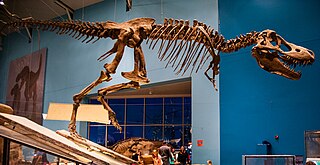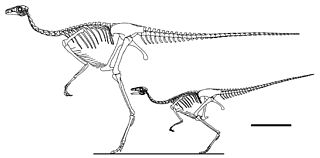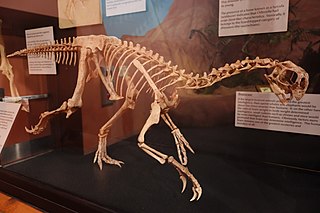
Tarbosaurus is a genus of tyrannosaurine theropod dinosaur that lived in Asia about 70 million years ago, during the Maastrichtian age at the end of the Late Cretaceous period, considered to contain a single known species: Tarbosaurus bataar. Fossils have been recovered from the Nemegt Formation of Mongolia, with more fragmentary remains found further afield in the Subashi Formation of China.

Oviraptor is a genus of oviraptorid dinosaur that lived in Asia during the Late Cretaceous period. The first remains were collected from the Djadokhta Formation of Mongolia in 1923 during a paleontological expedition led by Roy Chapman Andrews, and in the following year the genus and type species Oviraptor philoceratops were named by Henry Fairfield Osborn. The genus name refers to the initial thought of egg-stealing habits, and the specific name was intended to reinforce this view indicating a preference over ceratopsian eggs. Despite the fact that numerous specimens have been referred to the genus, Oviraptor is only known from a single partial skeleton regarded as the holotype, as well as a nest of about fifteen eggs and several small fragments from a juvenile.

Therizinosaurus is a genus of very large therizinosaurid that lived in Asia during the Late Cretaceous period in what is now the Nemegt Formation around 70 million years ago. It contains a single species, Therizinosaurus cheloniformis. The first remains of Therizinosaurus were found in 1948 by a Mongolian field expedition at the Gobi Desert and later described by Evgeny Maleev in 1954. The genus is only known from a few bones, including gigantic manual unguals, from which it gets its name, and additional findings comprising fore and hindlimb elements that were discovered from the 1960s through the 1980s.

Nomingia is a genus of oviraptorid theropod dinosaur hailing from the Late Cretaceous Bugin Tsav Beds of Mongolia.

Conchoraptor is a genus of oviraptorid dinosaurs that lived in Asia during the Late Cretaceous epoch, about 70 million years ago. It is known from the Barun Goyot and Nemegt formations of Mongolia.

Bagaceratops is a genus of small protoceratopsid dinosaurs that lived in Asia during the Late Cretaceous, around 72 to 71 million years ago. Bagaceratops remains have been reported from the Barun Goyot Formation and Bayan Mandahu Formation. One specimen may argue the possible presence of Bagaceratops in the Djadochta Formation.

Sinornithomimus is a genus of ornithomimid that lived in Asia during the Late Cretaceous period. The first remains were found in 1997, in the Late Cretaceous strata of the Ulansuhai Formation located at Alshanzuo Banner, Inner Mongolia Autonomous Region, Northern China.

Heyuannia is a genus of oviraptorid dinosaur that lived in Asia during the Late Cretaceous epoch, in what is now China and Mongolia. It was the first oviraptorid found in China; most others were found in neighbouring Mongolia. Two species are known: H. huangi, named by Lü Junchang in 2002 from the Dalangshan Formation; and H. yanshini, originally named as a separate genus Ingenia from the Barun Goyot Formation by Rinchen Barsbold in 1981, and later renamed to Ajancingenia in 2013 due to the preoccupation of Ingenia. The latter name was eventually discarded due to various ethical issues surrounding the author.

Nemegtomaia is a genus of oviraptorid dinosaur from what is now Mongolia that lived in the Late Cretaceous Period, about 70 million years ago. The first specimen was found in 1996, and became the basis of the new genus and species N. barsboldi in 2004. The original genus name was Nemegtia, but this was changed to Nemegtomaia in 2005, as the former name was preoccupied. The first part of the generic name refers to the Nemegt Basin, where the animal was found, and the second part means "good mother", in reference to the fact that oviraptorids are known to have brooded their eggs. The specific name honours the palaeontologist Rinchen Barsbold. Two more specimens were found in 2007, one of which was found on top of a nest with eggs, but the dinosaur had received its genus name before it was found associated with eggs.

The Barun Goyot Formation is a geological formation dating to the Late Cretaceous Period. It is located within and is widely represented in the Gobi Desert Basin, in the Ömnögovi Province of Mongolia.

The Nemegt Formation is a geological formation in the Gobi Desert of Mongolia, dating to the Late Cretaceous. The formation consists of river channel sediments and contains fossils of fish, turtles, crocodilians, and a diverse fauna of dinosaurs, including birds.

Ceratonykus is a monospecific genus of alvarezsaurid dinosaur from Mongolia that lived during the Late Cretaceous in what is now the Barun Goyot Formation. The type and only species, Ceratonykus oculatus, is known from a fragmentary skeleton, including an incomplete skull, of an adult individual. It was named and described in 2009 by Vladimir Alifanov and Rinchen Barsbold. Its describers questioned the traditional placement of alvarezsaurs in Theropoda, instead suggesting they were ornithischians, but this has not been accepted since. Ceratonykus has an estimated length of 75 centimetres and weight of 760 grams. It has been considered as a possible junior synonym of Parvicursor.

The Bayan Mandahu Formation is a geological unit of "redbeds" located near the village of Bayan Mandahu in Inner Mongolia, China Asia and dates from the late Cretaceous Period. Laid down in the Campanian, it is dated somewhat uncertainly to between 75 and 71 mya.

Machairasaurus is a genus of oviraptorid dinosaur which was found in the Bayan Mandahu Formation, China, dating to the late Cretaceous period.

This timeline of oviraptorosaur research is a chronological listing of events in the history of paleontology focused on the oviraptorosaurs, a group of beaked, bird-like theropod dinosaurs. The early history of oviraptorosaur paleontology is characterized by taxonomic confusion due to the unusual characteristics of these dinosaurs. When initially described in 1924 Oviraptor itself was thought to be a member of the Ornithomimidae, popularly known as the "ostrich" dinosaurs, because both taxa share toothless beaks. Early caenagnathid oviraptorosaur discoveries like Caenagnathus itself were also incorrectly classified at the time, having been misidentified as birds.

Oksoko is a genus of oviraptorid dinosaur from the Late Cretaceous of Asia, that lived in what is now the Nemegt Formation in Mongolia. It includes the type species Oksoko avarsan.
Khulsanurus is an extinct genus of alvarezsaurid theropod dinosaur from the Late Cretaceous Barungoyot Formation of the Khulsan Locality in the Gobi Desert region of Mongolia. The type and only species is Khulsanurus magnificus.

Ondogurvel is a genus of alvarezsaurid dinosaur from the Late Cretaceous (Campanian) Barun Goyot Formation in southern Mongolia. The type and only species is O. alifanovi, known from a partial skeleton consisting of fragments of two last dorsal vertebrae, three anterior sacral vertebrae, right ilium, left and right pubis and ischium, articulated right tibia, fibula, metatarsals II and IV, and phalanges IV-1 and IV-2, right carpometacarpus, left and right manual phalanx II-1, right femur, left pedal phalanx II-1, and fragments of unidentified phalanges.

Natovenator is a genus of halszkaraptorine dromaeosaurid dinosaur from the Late Cretaceous Barun Goyot Formation of Mongolia. The genus is known from a single species, N. polydontus. Natovenator is crucial to the understanding of halszkaraptorines due to it providing more support for the semi-aquatic lifestyle that has been proposed for this clade. This discovery is important as the semi-aquatic lifestyles of halszkaraptorines was contested in early 2022.

Jaculinykus is an extinct genus of alvarezsaurid theropod dinosaur from the Late Cretaceous Baruungoyot Formation of Mongolia. The genus contains a single species, J. yaruui, known from a nearly complete articulated skeleton including bones of the skull. Jaculinykus is notable for its unique hand, which has a hypertrophied first digit and greatly reduced second digit, which is intermediate between the tridactyl hand of Shuvuuia and monodactyl hand of Linhenykus.


















